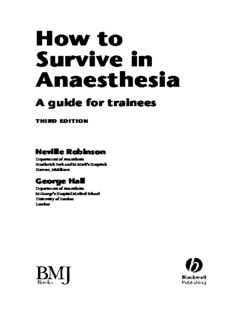Table Of ContentHow to
Survive in
Anaesthesia
A guide for trainees
THIRD EDITION
Neville Robinson
DepartmentofAnaesthesia
NorthwickParkandStMark’sHospitals
Harrow,Middlesex
George Hall
DepartmentofAnaesthesia
StGeorge’sHospitalMedicalSchool
UniversityofLondon
London
How to
Survive in
Anaesthesia
Aguidefortrainees
THIRDEDITION
How to
Survive in
Anaesthesia
A guide for trainees
THIRD EDITION
Neville Robinson
DepartmentofAnaesthesia
NorthwickParkandStMark’sHospitals
Harrow,Middlesex
George Hall
DepartmentofAnaesthesia
StGeorge’sHospitalMedicalSchool
UniversityofLondon
London
(cid:2)C 2007NevilleRobinson&GeorgeHall
PublishedbyBlackwellPublishingLtd
BMJBooksisanimprintoftheBMJPublishingGroupLimited,usedunderlicence
BlackwellPublishing,Inc.,350MainStreet,Malden,Massachusetts02148-5020,USA
BlackwellPublishingLtd,9600GarsingtonRoad,OxfordOX42DQ,UK
BlackwellPublishingAsiaPtyLtd,550SwanstonStreet,Carlton,Victoria3053,Australia
TherightoftheAuthortobeidentifiedastheAuthorofthisWorkhasbeenassertedinaccordance
withtheCopyright,DesignsandPatentsAct1988.
Allrightsreserved.Nopartofthispublicationmaybereproduced,storedinaretrievalsystem,or
transmitted,inanyformorbyanymeans,electronic,mechanical,photocopying,recordingor
otherwise,exceptaspermittedbytheUKCopyright,DesignsandPatentsAct1988,withoutthe
priorpermissionofthepublisher.
Firsteditionpublished1997
Secondeditionpublished2002
Thirdeditionpublished2007
1 2007
ISBN-13:978-1-4051-46456
ISBN-10:1-4051-46451
LibraryofCongressCataloging-in-PublicationData
Robinson,Neville.
Howtosurviveinanaesthesia:aguidefortrainees/NevilleRobinson,GeorgeHall.–3rded.
p.;cm.
Includesindex.
ISBN-13:978-1-4051-4645-6(paperback)
ISBN-10:1-4051-4645-1(paperback)
1.Anesthesiologists–Trainingof. 2.Anesthesiology–Studyandteaching.
3.Anesthesia. I.Hall,GeorgeM.(GeorgeMartin) II.Title.
[DNLM:1.Anesthesia–methods. WO200R663h2007]
RD81.R6322007
617.9(cid:3)60071–dc22
2006021260
AcataloguerecordforthistitleisavailablefromtheBritishLibrary
Setin9.5/12byTechBooks,India
PrintedandboundinSingaporebyMarkonoPrintMediaPteLtd
CommissioningEditor:MaryBanks
EditorialAssistant:VictoriaPittman
DevelopmentEditor:LaurenBrindley
ProductionController:DebbieWyer
ForfurtherinformationonBlackwellPublishing,visitourwebsite:
http://www.blackwellpublishing.com
Thepublisher’spolicyistousepermanentpaperfrommillsthatoperateasustainableforestry
policy,andwhichhasbeenmanufacturedfrompulpprocessedusingacid-freeandelementary
chlorine-freepractices.Furthermore,thepublisherensuresthatthetextpaperandcoverboard
usedhavemetacceptableenvironmentalaccreditationstandards.
BlackwellPublishingmakesnorepresentation,expressorimplied,thatthedrugdosagesinthis
bookarecorrect.Readersmustthereforealwayscheckthatanyproductmentionedinthis
publicationisusedinaccordancewiththeprescribinginformationpreparedbythemanufacturers.
Theauthorandthepublishersdonotacceptresponsibilityorlegalliabilityforanyerrorsinthe
textorforthemisuseormisapplicationofmaterialinthisbook.
Contents
Listofboxes,vii
Listoffigures,xi
Listoftables,xii
Prefacetothethirdedition,xiii
Prefacetothesecondedition,xiv
Prefacetothefirstedition,xv
PartI: Nutsandbolts,1
Chapter1: Evaluationoftheairway,3
Chapter2: Controloftheairway,8
Chapter3: Trachealintubation,13
Chapter4: Failedintubationdrill,18
Chapter5: Vascularaccess,21
Chapter6: Intravenousfluids,25
Chapter7: Theanaestheticmachine,28
Chapter8: Anaestheticbreathingsystems,36
Chapter9: Ventilatorsandotherequipment,42
Chapter10: Monitoringinanaesthesia,46
PartII: Crisesandcomplications,53
Chapter11: Cardiacarrest,55
Chapter12: Haemorrhageandbloodtransfusion,61
Chapter13: Anaphylacticreactions,68
Chapter14: Malignanthyperthermia,72
Chapter15: Stridor–upperairwayobstruction,77
v
vi Contents
Chapter16: Pneumothorax,82
Chapter17: Commonintraoperativeproblems,85
Chapter18: Postoperativeproblems,92
Chapter19: Anaestheticmishaps,100
PartIII: Passingthegas,105
Chapter20: Preoperativeevaluation,107
Chapter21: Recognitionandmanagementofthesickpatient,112
Chapter22: Principlesofemergencyanaesthesia,115
Chapter23: Regionalanaesthesia,123
Chapter24: Anaesthesiaforgynaecologicalsurgery,133
Chapter25: Anaesthesiaforurologicalsurgery,139
Chapter26: Anaesthesiaforabdominalsurgery,147
Chapter27: AnaesthesiafordentalandENTsurgery,152
Chapter28: Anaesthesiafororthopaedicsurgery,158
Chapter29: Anaesthesiafordaycasesurgery,164
Chapter30: Managementofthepatientintherecoveryarea,167
Chapter31: Postoperativeanalgesia,171
Chapter32: Managementofheadinjuries,177
Chapter33: Anaesthesiainthecorridor,181
Chapter34: Anaestheticaphorisms,185
Index,189
List of boxes
1.1 Assessmentoftheairway,3
1.2 Medicalfeaturesofdifficultairwayintubation,4
1.3 Anatomicalfeaturesofdifficultairwaycontrolandintubation,4
2.1 Methodsofairwaycontrol,5
3.1 Intubationtechniques,13
3.2 Clinicalsignsusedtoconfirmtrachealintubation,14
3.3 Technicalteststoconfirmintubation,15
3.4 Complicationsoftrachealintubation,17
4.1 Initialcourseofactionforfailedintubation,18
4.2 Subsequentdecisionsforconsiderationafterfailedintubation,19
5.1 Complicationsofinternaljugularveincatheterisation,23
5.2 Variantsincentralvenouspressure,23
7.1 Anaestheticmachinecomponents,28
7.2 Oneatmosphereofpressure(variousunits),28
7.3 Anaestheticmachinechecklist,32
8.1 Anaestheticbreathingcircuitcomponents,36
8.2 Functionsofbagsinbreathingsystems,37
9.1 Typesofventilators,42
9.2 Suctiondevicecomponents,44
9.3 Scavengingsystemcomponents,44
10.1 Anaesthesiamonitoringrequirements,46
10.2 Patientmonitoringdevices,48
10.3 Specialisedpatientmonitoringdevices,49
10.4 Causesoflowoxygensaturation,50
10.5 CommoncausesofhighandlowP CO ,51
a 2
11.1 Adultbasiclifesupport,57
11.2 Adultadvancedlifesupportincardiacarrest,57
11.3 Potentiallyreversiblecausesofcardiacarrest,57
12.1 Bloodlossestimation,61
12.2 Additivesusedinredcellstorage,62
12.3 Bloodtransfusioncomplications,64
vii
viii Listofboxes
12.4 Bloodvolumeformulae,66
13.1 Signsofsevereallergicdrugreactions,68
13.2 Anaphylaxis–immediatemanagement,69
13.3 Anaphylaxis–secondarymanagement,70
14.1 Clinicalsignsofmalignanthyperthermia(MH),74
14.2 Metabolicsignsofmalignanthyperthermia,74
14.3 Overallmanagementplanformalignanthyperthermia,75
14.4 Anaesthesiainsuspectedmalignanthyperthermia,76
15.1 Commoncausesofupperairwayobstruction,77
15.2 Symptomsandsignsofupperairwayobstruction,78
16.1 Causesofpneumothorax,82
16.2 Signsofpneumothoraxinanaesthesia,83
17.1 Commoncausesofintraoperativeproblems,86
17.2 Drugtreatmentoflife-threateningarrhythmias,87
17.3 Majorcausesofintraoperativehypotension,88
17.4 Causesofintraoperativehypertension,89
17.5 Managementoflaryngospasm,89
17.6 Differentialdiagnosesofwheeze,90
18.1 Signsofairwayobstruction,92
18.2 Commoncausesofpostoperativeairwayobstruction,93
18.3 Commoncausesoffailuretobreathe,94
18.4 Unusualcausesoffailuretobreathepostoperatively,94
18.5 Signsofadequateneuromuscularfunction,94
18.6 Factorsassociatedwithpostoperativevomiting,96
18.7 Causesofdelayedrecovery,97
18.8 Factorspredisposingtopostoperativehypothermia,98
18.9 Preventionofbodyheatloss,98
18.10 Causesofhyperthermia,98
20.1 Classificationofoperations,107
20.2 ASAphysicalstatusclasses,108
20.3 Specificassessmentofobesity,109
20.4 Basicpreoperativetests,109
20.5 Reasonsforpremedication,110
21.1 Principlesofcareinthesicksurgicalpatient,112
22.1 Componentsofgeneralanaesthesia,115
22.2 Classificationofanaesthetictechniques,116
22.3 Methodsoffacilitatingtrachealintubation,117
22.4 Managementofendotrachealintubationwhenrisk
ofaspiration,118
22.5 Majorsideeffectsofsuxamethonium,120
Description:How to Survive in Anaesthesia, third edition, continues to provide an essential, step-by-step guide for new trainees to practical procedures in anaesthesia.Written in a light-hearted style by authors with 60 years of anaesthetic experience between them Includes two new chapters on anaesthetic mishap

